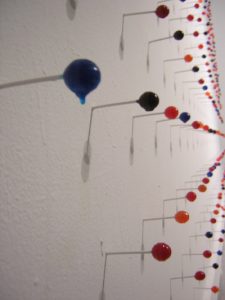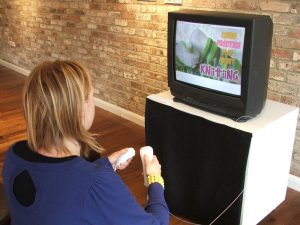



Rachel Beth Egenhoefer considers her Commodore 64 Computer and Fischer Price Loom to be defining objects of her childhood. She creates tactile representations of cyclical data structures in candy and knitting and is currently researching the intersection of textiles, technology, and the body.
Egenhoefer received her BFA from the Fiber department with a concentration in Digital Video from the Maryland Institute College of Art. Rachel Beth was an MFA fellow at the University of California, San Diego where she also was a graduate researcher at UCSD’s Center for Research and Computing in the Arts (CRCA).
The self-proclaimed digital arts nerd formerly worked on the editorial staff of Artbyte Magazine in New York City, and continues freelance writing on art, modern society, and media culture. Her work has been exhibited internationally in Los Angeles, New York, the Netherlands, the Options 2002 Biennial in Washington DC, the Corcoran Gallery of Art, the Institute for Contemporary Art (ICA) London, the 2003 Boston Cyber Arts Festival, the Banff Centre for the Arts, ISEA 2004 in Tallinn Estonia, the Curtain University of Technology in Perth Australia, and others.
Currently Rachel Beth is focusing on new projects. She was an artist in residence at Tsinghua University in Beijing, China (November & December 2007) and worked as an Artist in Residence in the UK at the University of Brighton, Lighthouse Brighton and Furtherfield in London (January-May 2008).
Jess: What are the main differences (pros and/or cons) of creating a work that is to be experienced digitally, and that which is contained within physical material borders (sweets, fabric etc…)? – this is very much a question to you as a *creator*
Rachel Beth: In some ways I feel like this is a hard question for me to answer because my work is very much about bridging these two experiences and pointing out that they aren’t that different.
There’s lots of clich’e answers like the digital being accessible anywhere on the web and that the material has the traditional sense of making and ‘aura’, but my work really sits between them and is about bringing the two together. Making the digital tactile, and the tangible coded.
Jess: What aspects of the digital would you like to be able to bring into your future work?
Rachel Beth: My most recent work, and the work I did during my residency in the UK uses motion and acceleration tracking. I’d like to continue using ideas around mapping motion and interaction. I’m not so interested in data visualization but rather how mapping actions and systems can make for new interactions or parallels. I’ve also begun to work with hacking the Nintendo Wii that has just kind of opened a whole slew of ideas. So I can see myself working more with that.
Jess: Can you tell us a bit more about how you are hacking the Wii and what drew you to the Wii as part of your artistic practice?
Rachel Beth: I’m not exactly hacking the Wii as much as I am using it as another input device or a tool. The Wii and Wii Motes come equipped with blue tooth so they are fairly easy to interface with other things that use blue tooth. I’d been thinking a lot about motion, and the motion of interaction both with knitting and with computing, as well as thinking about doing some motion tracking things in my work and around the same time the Wii came out. It uses motion, speed, angles, balance as a means of input. Some of my other work uses play and games so it just seemed natural for me to want to use it. I think it also ties in with pop culture and interacting with technology. It’s been fun!

Jess: How would you define a literate reader/experiencer of your work? (I’m thinking especially of the lovely melting sweets…how do you want your IDEAL audience to participate?)
Rachel Beth: I don’t really have an ideal audience. I strive to have multiple entry points in my work. I’ve had computer scientists view my work who know much more about code than I do but never knew that a knitting pattern looks exactly the same, or ludites who hate technology but suddenly realize there are simple, beautiful concepts in computing. Some people see my work and don’t realize it’s even a piece, some people spend hours coming back and looking at it. I’m okay with either of these extremes. It’s my hope that people find something to grab on to or relate to. Leaving a door partly open allows other people to add their own perspective as well. It’s always rewarding (well most of the time rewarding) when people discover things in your work you didn?t see before.
Jess: When is a creative piece imbued with *artistic* quality? What gives it that extra oomph? – for you as creator AND experiencer?
Rachel Beth: I don’t think it’s something you can quantify really, and perhaps it’s different for every piece. It’s a delicate balance of concept and material, clarity without being literal, and being playfully smart.
Jess: What is the role of *code* or coding (literally or metaphorically) in the creation of your work?
Rachel Beth: I often say that my work is about the relationships between textiles and technology on a historical, conceptual, physical and constructional level. On the constructional level I am interested in the similarity between knits and purl stitches, and binary zeros and ones. Knitting (and similar codes in weaving) are of course very tactile, and coding is intangible. Code also comes into my work in less literal ways. I’m interested in how people like Agnes Martin or Foucault use order in their work. I think ordering things is a lot like coding. It’s sets of instructions, or patterns for play. I often leave room for chance as well. The option that I might drop a stitch, or the program will crash.
Jess: Thinking about your work as containing, at least on some level, a set of instructions or guide for viewers/readers/interactors implies that authorial control remains with the creator. As Foucault would have it, authorial intention can be a way to limit interpretations. Also, since you mention patterns for play, I’m remembering Caillois and his framework which posits play on two axes: total creativity and more extreme ruled complexity. Where on the graph do you envision your work sitting most comfortably and does this change depending on where you are exhibiting and the kind of work itself?
Rachel Beth: I’m not entirely sure what the diagram is supposed to imply. More rules = more creativity? Or less rules = more creativity? In either case, I’m not sure I could plot my work on this chart. I have been interested in how Foucault describes order and creating order. I can see how creating too many rules would limit the interpretation. I guess this is another one of those delicate balances artists strive for – creating order, or rules, or structures that set up a context from which the viewer can engage with the work bringing their own influences and also able to depart to other connections. In some ways, when I’m making my work I’m thinking about both the order I’m creating but also conceptually talking about how others might view order, using algorithms and sets of instructions as concept. With the exception maybe of my Wii Knitting (which has explicit instructions because it’s a game) I generally use sets of instructions as concept related to computing as apposed to instructions for how people are supposed to view my work.
Jess: Have you noticed any general differences in the way your work is approached?
Rachel Beth: I often think that my work sits in this space between. Given that I work both with textiles and technology I can show work in a textile/ fiber/ sculptural context and then show the same work or give the same presentation in a digital media/ technology context and it?s approached differently just because of the different context. Context always changes how things are approached, and also which pieces I choose to show in combination with others.

Jess: How does your own perception of your work change as you create it and then when it is *complete* (if it ever really is finished). Do you have a favourite piece?
Rachel Beth: As I work on anything I’m always thinking about how my work will be perceived? asking myself questions and making changes as part of my process. Specifically I think it’s different for every piece. Some projects I’ve researched, thought out, sketched, and had every explanation for things before I ever started, and then when I made it, I hated it. But that work usually evolves into something much more organic. This is how ‘Lollipop Grid’ came about. I like to watch people view/ interact with my work. I’m not sure my perception changes per say, but I get new insight into my work? I did a show at Lighthouse in Brighton that was all work in progress. It was the first time I ever did that and I was a bit nervous about it. But it ended up being a great way to get things out of the studio and look at them in new light, then go back and keep working.
Jess: What would your perfect studio/workspace be like?
Rachel Beth: Ha, that’s good. I’m always thinking about dream houses and dream studios. I like spaces that are repurposed, old factories, warehouses, unique spaces with odd shapes. Big windows. Definitely a whole wall for all my books. Another wall to stick stuff up on, I’m always tacking up bits of paper, samples, notes, sketches, pictures, etc. Lots of floor space and tables that can be moved around and reconfigured for different projects. I guess that’s kinda what my studio is like right now only it’s a bit smaller than the dream version!
Rachel Beth Egenhoefer
http://www.rachelbeth.net
Info regarding Rachel Beth Egenhoefer’s residency at
University of Brighton, Lighthouse and Furtherfield,
in the UK January ? April 2008.
http://www.scansite.org/scan.php?pid=415
Made possible by Distributed South
http://www.distributedsouth.org.uk